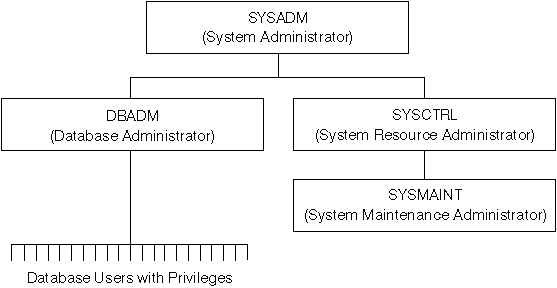
An authorization allows a user or group to perform a general task such as connecting to a database, creating tables, or administering a system. A privilege gives a user or group the right to access one specific database object in a specified way.
The database manager requires that a user be specifically authorized, either implicitly or explicitly, 13 to use each database function needed by that user to perform a specific task. Thus to create a table, a user must be authorized to create tables; to alter a table, a user must be authorized to alter the table; and so on.
Figure 7. Hierarchy of Authorities and Privileges

The person or persons with administrative authority have the task of controlling the database manager and are responsible for the safety and integrity of the data. They control who will have access to the database manager and to what extent each user has access.
The database manager provides two administrative authorities:
and two system control authorities:
SYSADM authority is the highest level of authority and has control
over all the resources created and maintained by the database manager. SYSADM authority includes all the privileges of DBADM, SYSCTRL, and SYSMAINT, and the authority to grant or revoke DBADM authorities.
DBADM authority is the administrative authority
specific to a single database. This authority includes privileges to create objects, issue database commands, and access the data in any of its tables through SQL statements. DBADM authority also includes the authority to grant or revoke CONTROL and individual privileges.
SYSCTRL authority is the higher level of system control authority
and applies only to operations affecting system resources. It does not allow direct access to data. This authority includes privileges to create, update, or drop a database; quiesce an instance or database; and drop or create a table space.
SYSMAINT authority is the second level of system control authority.
A user with SYSMAINT authority can perform maintenance operations on all databases associated with an instance. It does not allow direct access to data. This authority includes privileges to update database configuration files, backup a database or table space, restore an existing database, and monitor a database.
Database authorities apply to those activities that an administrator has allowed a user to perform within the database that do not apply to a specific instance of a database object. For example, a user may be granted the authority to create packages but not create tables.
Privileges apply to those activities that an administrator or object owner has allowed a user to perform on database objects. Users with privileges can create objects, though they face some constraints, unlike a user with an authority like SYSADM or DBADM. For example, a user may have the privilege to create a view on a table but not a trigger on the same table. Users with privileges have access to the objects they own, and can pass on privileges on their own objects to other users by using the GRANT statement.
CONTROL privilege allows the user to access a specific database object as desired and to GRANT and REVOKE privileges to and from other users on that object. DBADM authority is required to grant CONTROL privilege.
Individual privileges and database authorities allow a specific function but do not include the right to grant the same privileges or authorities to other users. The right to grant table, view or schema privileges to others can be extended to other users using the WITH GRANT OPTION on the GRANT statement.